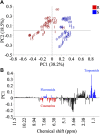Metabolomic Investigation of Citrus latifolia and the Putative Role of Coumarins in Resistance to Black Spot Disease
- PMID: 35813812
- PMCID: PMC9263546
- DOI: 10.3389/fmolb.2022.934401
Metabolomic Investigation of Citrus latifolia and the Putative Role of Coumarins in Resistance to Black Spot Disease
Abstract
Citrus black spot (CBS) is a disease caused by the fungus Phyllosticta citricarpa that affects citrus plants, causing fruit blemish and premature drop that result in severe economic losses in commercial citrus orchards. However, CBS symptoms and effects may vary depending on the citrus species: Citrus limon (lemon) is susceptible and highly affected by the disease, while no CBS-related damage has ever been observed for Citrus latifolia (Tahiti lime), implying that it must be resistant to the disease. The difference in the response to this disease provided the opportunity to gain insight into the metabolites responsible for the resistance by comparison of the metabolomic profiles of these two citrus species. Metabolic variations of C. limon and C. latifolia inoculated with P. citricarpa were analyzed using various metabolomic-based platforms including 1H NMR for overall metabolic profiling, and LC-MS and HPTLC for targeted analysis. The 1H NMR spectra of the samples demonstrated that certain phenolics were strongly induced after pathogenic inoculation, especially in the resistant species. The induced phenolics were identified from C. latifolia by further 1H NMR, LCMS and HPTLC analysis yielding six prenylated and methoxy coumarins, i.e., 5,7-dimethoxycoumarin, 5-geranyloxy-7-methoxycoumarin, 7-geranyloxycoumarin, 8-methoxypsoralen, 5,8-dimethoxypsoralen and 5-geranyloxypsoralen. These isolated coumarins and a coumarin-rich fraction were tested against the fungal pathogen, P. citricarpa, to evaluate their activity. None of the individual coumarins exhibited a significant inhibition, while the coumarin fraction exhibited a strong antifungal activity suggesting a synergistic interaction of its components. To obtain further insight into the roles of these compounds in the plant defense, the possible mechanisms of the individual coumarins were tested using an in-silico model, the PASS Online Tool; the analysis showed that each coumarin appeared to have a unique defense mechanism, even with very slight variations in the chemical structures. The results could provide evidence of the existence of a complex plant defense mechanism consisting in a multitude of synergistic interactions between compounds.
Keywords: citrus; coumarins; metabolomics; pant defense; pathogen.
Copyright © 2022 Fernandes, Salomé-Abarca, Gonçalves Pereira, Brandão Seibert, Silva-Junior, Das Graças Fernandes da Silva and Choi.
Conflict of interest statement
The authors declare that the research was conducted in the absence of any commercial or financial relationships that could be construed as a potential conflict of interest.
Figures




References
-
- Afek U., Orenstein J., Carmeli S., Rodov V., Joseph M. B. (1999). Umbelliferone, a Phytoalexin Associated with Resistance of Immature Marsh Grapefruit to Penicillium digitatum . Phytochemistry 50, 1129–1132. 10.1016/s0031-9422(98)00671-2 - DOI
-
- Afek U., Sztejnberg A. (1988). Accumulation of Scoparone, a Phytoalexin Associated with Resistance of Citrus toPhytophthora Citrophthora. Phytopathology 78 (12), 1678–1682. 10.1094/phyto-78-1678 - DOI
-
- Agrianual (2019). Available in https:\\www.agrianual.com.br – (accessed on June 19th .
LinkOut - more resources
Full Text Sources
Research Materials

